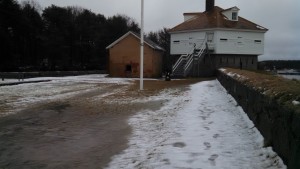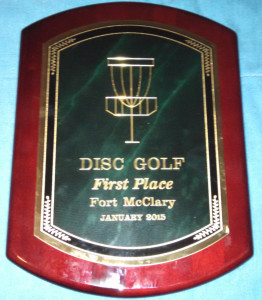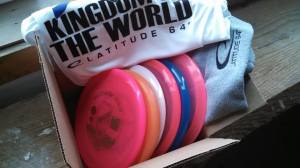Quite the weekend to start off the new year. In what has become a tradition for me (6 years running now), I participated in a tradition that dates back to the mid-1970s. That tradition has come to be known as First Folf at Fort McClary.
But before the fun began on Sunday, I got the good news on Saturday that my sponsorship deal with Latitude 64 and Westside Discs has been extended through 2015. Wahoo.
And even more fun (of a more sarcastic nature) was had on the drive to Fort McClary on Sunday morning as the tail-end of a messy snow-ice-rain storm was passing through. The good news is road conditions weren’t as bad as they could have been and all the precipitation passed through by the time we started playing. The bad news is that the weather apparently scared off a bunch of regular participants in the event so the field was smaller than usual.
Fort McClary is a small state park in Kittery Point, Maine. The land had been fortified in some way since the late 17th century protecting the mouth of the Piscataqua River where it entered the Atlantic Ocean through Portsmouth Harbor and Pepperrell Cove. The Fort was officially established and militarized in the 19th century. It has been maintained as a park and an historic site since the 1920s.

The park is divided into two parts by the main road through the village. The “park side” consists of a playground and picnic area, some nature trails, and a small pond that is frequently used in the winter for hockey. The “fort side” nearer the water features old buildings and battlements.
The tradition of frisbee golf (true frisbee golf with actual Frisbees) at the Fort dates to the early/mid 1970s when a group of friends would play their made up course at the Fort just because they had free time and loved throwing Frisbees. As these friends aged and graduated and moved on with their respective lives, they made a pact to always gather once a year (on or around New Years Day) at the Fort to “relive” the old days and play frisbee golf. And they’ve stuck with it, getting their children involved and soon enough, probably their children’s children as well.
The “Folf” crew has grown from the original handful not just through growing families, but through inviting new friends and acquaintances to play (you tell two friends, and they tell two friends, and so on). That’s how I came to be a participant.
I have family ties to Kittery Point. My father grew up there. My grandmother still lives there. I spent many hours of my childhood playing on the playgrounds at Fort McClary when we visited family.

So in playing various disc golf tournaments, my father, my uncle and I all became acquainted with one of the original Folfers. And in the course of conversation, the common connection of the Fort came up and the invitations to play the First Folf event were offered. All three of us jumped in (some sooner than others…I was actually the last to join in the fun) and now we all look forward to starting the new year with First Folf.
The event itself consists of a single round of 18 holes, followed by lunch and awards (and usually thawing out) at a local restaurant. Over the years, the “course” has changed with new holes and targets tried and new angles thought up. The current layout used in the last few years has more or less stabilized into something that the original Folfers say is pretty close to their original design (give or take a few trees and objects).
This old school course is entirely made up of object targets. They range from throwing the disc through a “V” created by two birch trees to striking park signs, doors and flag poles to landing on an elevated platform that is part of a piece of playground equipment.

Some targets are used multiple times. One object, a large well cover, is not only used twice as a target, but twice as a tee as well (it is the tee for one of the holes playing to the pictured flagpole above). There are also a number of mandatories that have to be navigated. For example, one hole forces you to throw between two specific trees before taking a 90 degree turn to the left and playing to the door of the men’s room.
A few mandatories are actually windows in buildings through which you have to pass before completing the hole. The window in the brown building pictured above is one such example. There are windows on two sides of the aforementioned well cover. One hole forces you to come through one of the windows on one side of the building before landing on the cover. Later you must enter through one of the windows on the other side before again landing on the cover.
Sometimes, mandatories are the targets as well. There is one hole in which you must throw your disc through a crotch in the tree, but can only do so in one particular direction. Still other targets, like the men’s room door and the “zebra” striped sign, can only be struck on one side.
All this adds up to a golf course that puts a huge premium on placement and approach angles over distance. The only holes that exceed 230 feet bend around mandatories that make it difficult if not impossible to cover the whole distance in one throw. Many times, the difference between getting a two or a three on a given hole is landing one foot further to the left or the right and being lined up to be able to hit the target properly.
Case in point, I had drives on both holes playing to the well cover that had it traveled just a foot or two further, I’d have been lined up with a dead straight shot through the window directly to the well cover. Instead, I was forced to lay up (8 feet on one, 12 on the other) to give myself a putt.
Fortunately, despite a few of those hard to swallow extra throws, I was able to throw the lowest score of the day amongst the 12 participants. It was my second time doing so in my six years of playing the event, but the first time being the solo low score (no tiebreakers at First Folf).

With the conclusion of First Folf, my 2015 season is underway. I intend to be a bit more diligent with the blog and update it with every event I play (most probably won’t be quite this long). We’ll see how that goes.
I’ll just conclude with a formal invitation to anyone reading to visit and “friend” the Fort McClary Folf page at Facebook and then feel free to join in on the fun of playing at the Fort. There are tentative plans to do a doubles tournament in March, which would be the third year running of that event. That one is two rounds and yours truly (with my partner Charlie Sawyer) is the defending champ. We welcome any and all challengers. 🙂


